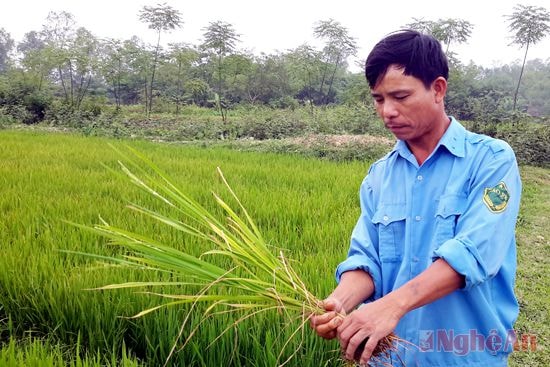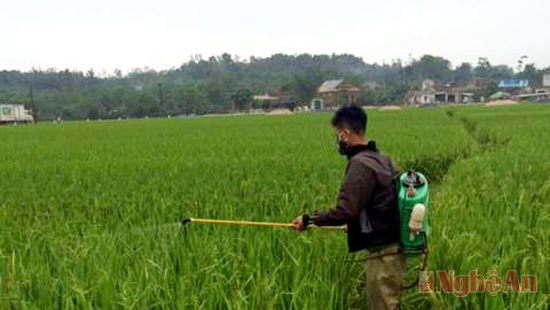Proactively care for and protect spring rice
(Baonghean) - Abnormal weather is increasing the risk of diseases breaking out in spring rice; effective prevention and control will be decisive for the important growth stage as well as the yield of this spring rice crop.
 |
| Rice leaves are blighted in Hung Tien commune (Nam Dan). |
Controlling the risk of neck blast disease
This spring crop, Thanh Chuong planted 8,200 hectares of rice; currently, nearly 2,000 hectares are entering the milky ripening period, the remaining area is blooming. The district has directed the spraying of rice blast disease prevention for over 3,000 hectares of spring rice, when the whole district only has nearly 160 hectares infected with leaf blast disease.
Head of the Department of Agriculture of Thanh Chuong district - Mr. Le Dinh Thanh said: "Bladder blast is an extremely dangerous disease and can only be prevented but not eradicated, so from April 3, the district organized a meeting to restore spring crop production, in which special attention was paid to pest control on rice plants. From there, the communes were directed to recommend and urge people to spray to prevent rice blast and grain smut on almost the entire area, especially in areas that have been affected by leaf blast and are at high risk of infection."
Specifically learning about the implementation at the grassroots level, in Thanh Dong commune, talking with Ms. Nguyen Thi Thao, a resident of hamlet 10 of Thanh Dong commune, learned that: Her family has 2.4 sao of Nhi Uu 986 rice, near the end of March, when visiting the field, she discovered that the rice had leaf blast disease, although the disease was only scattered, but she promptly bought pesticides according to the recommendations of the commune's agricultural staff, thanks to which the disease was contained and controlled in a small area, not allowing it to spread. "Now, no one in the field has seen rice with neck blast disease, but the weather is erratic like this, we must follow the recommendations of the commune and hamlet, spraying immediately to not affect the rice yield" - Ms. Thao said.
Currently, in addition to the nearly 40,000 hectares of spring rice that have already bloomed, the remaining spring rice area is expected to bloom concentratedly between April 20 and May 5. According to the report of the Plant Protection Department (PPD), most localities have taken measures to prevent neck blast disease; but by the afternoon of April 21, the Department of Agriculture of Anh Son district said that neck blast disease appeared on 2 hectares of rice in the area.
In Tan Ky, at the end of March 2015, leaf blast disease appeared on over 800 hectares out of a total of 4,500 hectares of spring rice in the district. Therefore, the district pays special attention to the issue of preventing neck blast disease. According to Mr. Nguyen Ba Thuc - Head of the Agriculture Department of Tan Ky district: The whole district basically has only one concentrated rice crop from April 20 to 25. On April 13, the district held a meeting, directing all communes to deploy a spraying campaign to prevent neck blast disease, assigning the district Plant Protection Station to coordinate with local pesticide suppliers to disseminate techniques, introduce and supply specific drugs to people. Currently, communes are simultaneously organizing spraying, paying special attention to areas that have been infected with leaf blast and disease-sensitive varieties such as BC15, AC5...
In March 2015, the rice blast disease broke out, spread and caused serious damage on a large scale. The whole province had 8,500 hectares of rice infected, of which more than 1,100 hectares were severely infected and over 100 hectares were "burned" with a diseased leaf rate of over 70%. Along with regularly monitoring the fields to determine areas that needed prevention, the Department of Agriculture coordinated with localities to focus on directing farmers to use specific pesticides to spray on areas with a diseased leaf rate of 5% or more, when the rice was in the early tillering stage (heading) and had favorable weather conditions for the disease to develop. The rice area sprayed for prevention has now reached 9,500 hectares, including in addition to diseased areas, there are also high-risk areas and areas planted with susceptible varieties. Thanks to that, the rice blast disease has been basically controlled. However, the weather is still unpredictable, the rice fields that are about to bloom are likely to encounter rain and high humidity, which is favorable for the outbreak of rice blast disease, especially in rice fields that have been infected with leaf blast disease and in semi-mountainous areas with large day-night temperature ranges.
To proactively prevent and minimize the occurrence and damage caused by the disease, since the beginning of April, the Plant Protection Department has assigned staff to be in charge of the tea distribution area and accurately determine the area and flowering time of the rice fields, and proactively consulted and coordinated with localities to organize and guide farmers to spray disease prevention on the rice fields that are exposed to unfavorable weather conditions such as cloudy, rainy, high humidity, and foggy with one of the specific drugs such as: Beam 75WP, Katana 20SC, Filia 525 SE...
Mr. Pham Thanh Long - Deputy Head of the Department of Agricultural Plant Protection, said: Disease prevention is only effective when spraying early with specific drugs. If the rice is blooming in dry, hot weather, it is not necessary to organize prevention of neck blast. But since April 21, the monsoon has made the weather cool and cloudy, so spraying is very necessary. To achieve the highest spraying efficiency, we recommend that people spray when the rice starts to bloom and spray again when the rice has fully bloomed if the weather conditions continue to be favorable for the disease to develop. When spraying, it is necessary to ensure enough water for the medicine, at least 24 liters/sao, and spray in the evening or early morning to avoid the time when the rice is drying.
Thus, with the current humid weather, low temperatures and the appearance of rice blast disease in Anh Son; the Department of Agriculture recommends that farmers visit their fields more often, under the guidance of agricultural extension officers, to take timely measures to minimize the impact of the disease on rice productivity.
 |
| Spraying pesticides to prevent rice blast in Thanh Dong commune (Thanh Chuong). Photo: PV |
Effective response to yellow leaf phenomenon
Since April 12, after the cold air intensified causing cold rain in our province, in localities, the phenomenon of yellow leaves and leaf burn has appeared and damaged spring rice in most rice varieties, but concentrated in pure rice varieties, especially in fields with water shortage, this phenomenon occurs at a more severe level. According to statistics of the Plant Protection Department, the whole province has nearly 140,000 hectares of spring rice with yellow leaves and leaf burn.
In Nam Dan district, about 10% of the rice area has already blossomed, nearly 80% of the main crop tea area is bowing to bear ears and the remaining area is holding ears. Mr. Nguyen Dinh Hien (Hamlet 1, Hung Tien commune) has 5 sao of rice, of which 2 sao of sticky rice have yellow leaves. He said that, following the instructions of the agricultural extension officer, he bought growth stimulant to spray on the rice, and now his family's rice fields have turned green again.
According to Mr. Tran Van Cuong - Head of the Plant Protection Station of Nam Dan district, from April 12, some rice fields showed signs of discoloration and from April 15 onwards, the yellow color on the rice developed very quickly. The whole district has 350 hectares of rice with yellow leaves, concentrated on pure rice varieties, especially Khang Dan 18 on the teas in the final stage of embracing the panicle, dry rice fields, lacking water. However, through inspection and assessment by the Provincial Plant Protection Department after implementing many testing measures, it was concluded that this was not a disease, there were no disease spots and no spreading phenomenon, but according to the general assessment, it was just a physiological yellow leaf phenomenon due to sensitivity to adverse weather developments, when the temperature difference between day and night was too large. "Because it is not an epidemic, we do not recommend farmers to spray pesticides, but only ask communes to focus on pumping enough water for the rice plants to recover and form panicles. At the same time, with over 300 hectares of severe physiological yellow leaves, which may partially affect productivity, we recommend farmers spray growth stimulants to help the rice plants grow well," said Mr. Cuong.
In Do Luong district, from April 13 to 14, the phenomenon of yellow leaves also appeared and spread rapidly over 2,000 hectares of spring rice, concentrated in areas of direct-sown rice, fields lacking water, and fields fertilized with nitrogen, phosphorus, and potassium by people in an unbalanced manner.
Ms. Tran Thi Tam - Head of the Plant Protection Station of Do Luong district said: There are many diseases caused by viruses and bacteria, such as bacterial leaf blight, which also causes yellow leaves. But through inspection, we determined that this is not a disease but only a physiological yellowing phenomenon. This year, the area of rice with yellow leaves is larger, and the severity is also more severe than previous years, due to unusual weather changes. During the day, the temperature can reach up to 400C, but at night it is cool, the temperature difference between day and night is too large, so the rice plants are "shocked" by the weather. The station has advised the district to direct the communes to focus on pumping enough water, injecting growth regulators and stimulants. Currently, most of the area has recovered and turned green again, basically not affecting productivity.
The assessment of the Provincial Plant Protection Department also said that the cause of the yellowing of leaves on spring rice in recent times was due to complicated weather developments. After the cold air, the weather became hot and sunny, with a large difference in day and night temperatures, while the rice was in the stage of heading, a period sensitive to external conditions.
According to Mr. Pham Thanh Long: That phenomenon is not caused by microorganisms such as fungi, bacteria or viruses, so we do not instruct people to use pesticides to spray, except for spraying to prevent other pests on these areas. For areas that are severely affected, especially on dry rice fields, it is recommended to water to ensure the water level in the fields and to use some types of micronutrient fertilizers, foliar fertilizers rich in micronutrients (Zn, Cu, Mn...) to spray to help the rice recover faster and bloom; absolutely pay attention not to use foliar fertilizers, growth stimulants on rice areas infected with bacterial leaf blight, bacterial stripe spots... Up to now, through monitoring, the area of physiological yellow leaves in the whole province has not arisen to cause more serious damage, but the rice is showing a tendency to recover.
Phu Huong
| RELATED NEWS |
|---|






